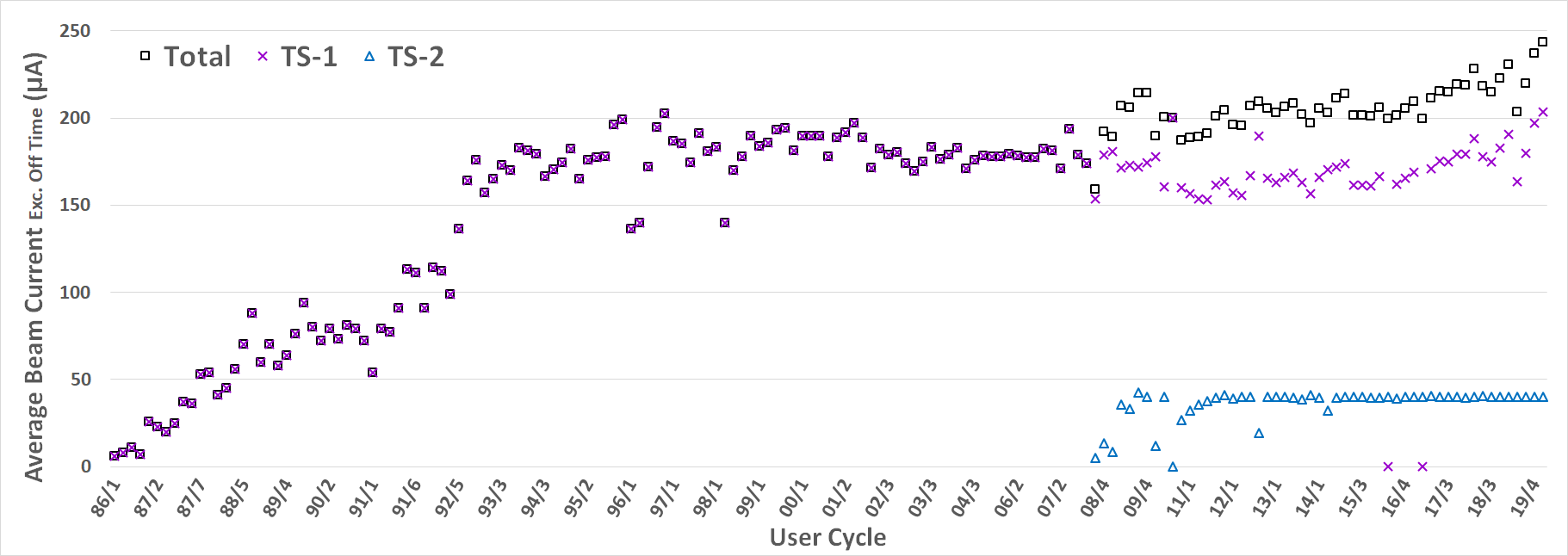 The Group are
responsible for delivering beam to the facility's neutron and muon user
community of over 2000 scientists worldwide. Since the addition of the
second target station in 2008, operating beam current has steadily improved due to the commissioning of upgrades to accelerator hardware and diagnostics. The synchrotron can now deliver an average beam current of 245 µA, the maximum required by the target stations.
The Group are
responsible for delivering beam to the facility's neutron and muon user
community of over 2000 scientists worldwide. Since the addition of the
second target station in 2008, operating beam current has steadily improved due to the commissioning of upgrades to accelerator hardware and diagnostics. The synchrotron can now deliver an average beam current of 245 µA, the maximum required by the target stations.
Further projects are ongoing to improve the reliability of the accelerators and prove concepts for ISIS-II.
Beam Loss Measurement and Control
Control of beam loss on collimation systems is also important for operation of high intensity machines. Experimental and simulation studies of the ISIS ring collimators with ORBIT and FLUKA [1], and use of ionisation and scintillator BLM's are helping improve loss control [2], reduce activation and lower personnel doses. This experience is now being applied to designs for collimation on the ISIS II rings.
Injection Stripping Foils
Thin foils are used to strip the negative hydrogen ion beam to protons as it is injected into the synchrotron. As part of the preparation for a megawatt facility ISIS transitioned from using in-house produced aluminium oxide foils to commercially sourced carbon foils in 2016 and is now trialling foils produced at Oakridge for the SNS.
The SNS foil proved to be a great improvement on the previously used carbon foils surviving a factor of 5 longer during beam operation. They have delivered significant savings in staff time and improved safety by received radiation exposure during foil replacement.

Pulse Compression for Muon Beams
Reconfiguring and optimisation of the RF and longitudinal dynamics at the end of the ISIS RCS acceleration process has a allowed a 20.8% reduction in pulse length of the extracted proton pulse, which has increased resolution of muon experiments [3]. Achieving this, whilst ensuring loss levels were maintained at 0.01% and maintaining reliable operation required careful design and implementation.
Non-destructive, Ring Profile Monitors
Non-destructive, time dependant
transverse profile measurements are essential for understanding and checking
simulation and theoretical models of high intensity rings. At ISIS extensive
studies of ionisation profile monitors (IPM’s) have advanced understanding and
modelling of errors due to drift field errors, space charge and effects of
different detected ions. Present studies are benchmarking results of IPM’s
against wire “harp” monitors in the extraction beam line, as confirmation of performance.
This follows an ongoing programme of monitor hardware and design development,
including studies of detector effects, calibration, variation in detector
sensitivity [4].
Head-tail Damper System
A prototype damper system for the ISIS head-tail instability has now been demonstrated at 50 Hz [5]. This is the first time such a system has been successfully implemented on a fast cycling machine, with such rapid changes in RF frequency and betatron tune.
[1] H V Smith et al, Activation Models of the ISIS Collectors, http://jacow.org/IPAC2014/papers/mopri115.pdf
[2] B Jones et al, Beam Loss Control with Scintillating Monitors at ISIS,
http://jacow.org/ipac2019/papers/wepgw091.pdf
[3] A D Hillier et al, J Phys, Conf Series 551 (2014) 012067, Developments at the ISIS Muon Source and Concomitant benefit to the User Community
https://iopscience.iop.org/article/10.1088/1742-6596/551/1/012067/pdf
[4] C C Wilcox et al, Studies od the Time Structure of Ionisation Beam Profile Measurements in the ISIS Extracted Proton Beam Line http://jacow.org/ibic2019/papers/tupp037.pdf
[5] A Pertica et al, Optimisation of the ISIS Proton Synchrotron Experimental Damping System, http://jacow.org/ibic2019/papers/mopp031.pdf
